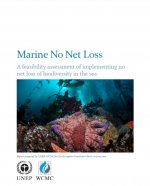Marine No Net Loss
A feasibility assessment of implementing no net loss of biodiversity in the sea
View PublicationThe oceans are under threat; marine species populations declined by 49% between 1970 and 2012 (WWF, 2015). Anthropogenic pressures on the marine environment have increased over the past five years, with 66% of the high seas and 77% of areas within national jurisdiction showing increased human impact (Halpern et al., 2015). On land, policy goals of no net loss, where project impacts on biodiversity are balanced by measures to avoid, minimise, restore, or offset those impacts, or net gain, where impacts are outweighed, have emerged as potential mechanisms to balance or outweigh negative development impacts on biodiversity.
This report, funded by the European Investment Bank (EIB), provides an initial high-level feasibility assessment of the potential for applying this concept to the marine environment. Desk based research combined with expert consultation was used to: (1) assess the impacts of each sector1 on biodiversity, (2) examine potential mechanisms for preventative and remediative conservation interventions by habitat type, and (3) review current no net loss practice in the marine environment.
Current practice, even offsetting, is remarkably widespread, despite the lack of a rigorous assessment of the suitability of a no net loss approach for the marine realm. We conclude that while there are challenges to implementing marine no net loss, these are not above and beyond those faced on land. There are a growing range of innovative solutions in development and a wealth of research from the terrestrial realm from which to draw important lessons.

